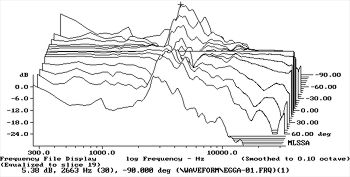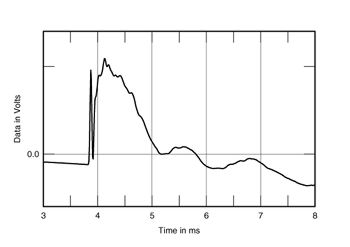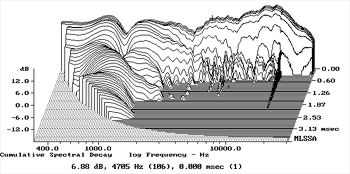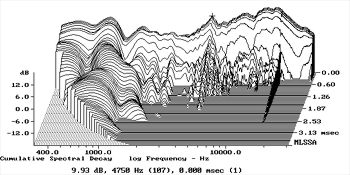| Columns Retired Columns & Blogs |
EgglestonWorks Andra loudspeaker Measurements part 3
It must be remembered that a loudspeaker's perceived balance doesn't depend only on the direct sound—that which first reaches the listener's ears—but also on the total radiated power into the room. Fig.7 shows how the response on the tweeter axis changes to the Andra's sides. (The data points are sparse in this graph, due to the fact that the Andra is too heavy for my automated speaker turntable. Again, the crossover suckout is worst directly on-axis, the "horns" between 2 and 4.5kHz to the sides of this graph suggesting that the speaker's total output into the room does not feature a lack of energy. Only in a small room, therefore, with the listener sitting close and low, will the Andra sound hollow. The larger the room and the farther away the listener, the better-balanced the EgglestonWorks will sound.

Fig.7 EgglestonWorks Andra, horizontal response family at 50", normalized to response on tweeter axis, from back to front: differences in response 90 degrees-5 degrees off-axis; reference response; differences in response 5 degrees-90 degrees off-axis.
Despite its sloped baffle and low-order crossover, the Andra is not time-coherent on typical listening axes. (It will be time-coherent around or below 20" from the floor, which suggests the tiltback of the baffle is too mild.) Fig.8, for example, shows the step response on the tweeter axis. The tweeter's output is the sharp up/down spike just before the 4ms mark, followed by the midrange units in the same acoustic polarity.

Fig.8 EgglestonWorks Andra, step response on tweeter axis at 50" (5ms time window, 30kHz bandwidth).
As with the frequency response, the nature of the Andra's cumulative spectral-decay plot depended very much on the measurement axis. Fig.9 shows the waterfall plot associated with the response in fig.6, 10 degrees above the tweeter axis. In general it is impressively clean, though there is some low-level hash present in the mid-treble. But if the microphone was lowered by 5 degrees, nearer the tweeter axis (fig.10), a resonant mode at 4.7kHz appeared, associated with a response peak at the same frequency. This and the excess of top-octave energy might tend to make the balance rather bright, everything else being equal. Note that I did not measure the speaker's distortion performance. However, I suspect that it is superbly low.

Fig.9 EgglestonWorks Andra, cumulative spectral-decay plot at 50", 10 degrees above the tweeter axis (0.15ms risetime).

Fig.10 EgglestonWorks Andra, cumulative spectral-decay plot at 50", 5 degrees above the tweeter axis (0.15ms risetime).
Overall, interpreting the EgglestonWorks Andra's measured performance in light of what both Wes Phillips and I heard when we auditioned the speaker proved more of a detective story than is usual. The broad overlap between the drive-units and ports makes the Andra's performance rather more room- and setup-dependent than those of more conventional speakers. But when everything is right, I agree with WP that this speaker offers a superb view into the music.—John Atkinson
- Log in or register to post comments




































